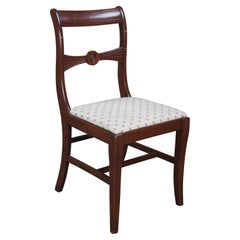Duncan Phyfe Bow Back Dining Chairs
Recent Sales
Vintage 1940s Regency Side Chairs
Upholstery, Mahogany
A Close Look at Regency Furniture
Like France’s Empire style, Regency-style furniture was rooted in neoclassicism; the characteristics of its bedroom furniture, armchairs, dining room tables and other items include clean lines, angular shapes and elegant details.
Dating roughly from the 1790s to 1830s, antique Regency-style furniture gets its name from Prince George of Wales — formally King George IV — who became Prince Regent in 1811 after his father, George III, was declared unfit to rule. England’s Regency style is one of the styles represented in Georgian furniture.
George IV’s arts patronage significantly influenced the development of the Regency style, such as the architectural projects under John Nash, which included the renovation of Buckingham House into the formidable Buckingham Palace with a grand neoclassical facade. Celebrated designers of the period include Thomas Sheraton, Henry Holland and Thomas Hope. Like Nash, Hope instilled his work with classical influences, such as saber-legged chairs based on the ancient Greek klismos. He is credited with introducing the term “interior decoration” to English with the 1807 publishing of Household Furniture and Interior Decoration.
Although more subdued than previous styles like Rococo and Baroque, Regency interiors incorporated copious use of chintz fabrics and wallpaper adorned in chinoiserie-style art. Its furniture featured fine materials and luxurious embellishments. Furniture maker George Bullock, for instance, regularly used detailed wood marquetry and metal ornaments on his pieces.
Archaeological discoveries in Egypt and Greece informed Regency-era details, such as carved scrollwork, sphinxes and palmettes, as well as the shape of furniture. A Roman marble cinerary chest, for example, would be reinterpreted into a wooden cabinet. The Napoleonic Wars also inspired furniture, with martial designs like tented beds and camp-style chairs becoming popular. While the reddish-brown mahogany was prominent in this range of pieces, imported woods like zebrawood and ebony were increasingly in demand.
Find a collection of antique Regency tables, seating, decorative objects and other furniture on 1stDibs.
Finding the Right Side-chairs for You
Antique and vintage side chairs are space savers by design and wonderfully versatile pieces of seating for your dining room or wherever guests may gather.
Chairs have been indispensable pieces of furniture for a long time. We sit, therefore we deserve good seating. In Ancient Egypt, chairs were utilized in homes regardless of class, and most furniture was made of wood. Comfortable folding chairs, for example, were found in King Tutankhamun’s tomb.
Chairs evolved to be more commonplace in the 1830s, and by the Industrial Revolution, they could be found in most homes. The traditional wooden side chair might feature an upholstered back and seat and was typically used for gathering around a big dining room table. Because the side chair does not feature armrests, it could easily be tucked under the table when not in use or delicately placed in a corner for decorative purposes. Today, the side chair’s slim silhouette and armless design still offer the same level of versatility as it did in its early days. It’s supportive of a large gathering for a meal in the dining room or kitchen and serves as an accent piece (or extra seating) resting against the wall in a living room or inviting foyer.
When shopping for side chairs, think about the colors and furniture style you’ve already introduced to your living room or dining room. Keep the height of your sofa in mind, for example. If you intend to pair your sofa with your side chair when it’s not perched near the dining table, it wouldn’t hurt if the height of your side chair matches the height of your sofa. Even if your side chair will largely be used in the kitchen or dining room, it will likely be used in the living room or home entertainment area as well. When you’re thinking about the seating where meals are served in your home, benches, stools and armchairs make suitable alternatives too. And if you’re feeling adventurous, combining a variety of dining room seating options can be both aesthetically pleasing and downright practical.
Side chairs are available in a number of styles today, and this convenient seating is one of the types of chairs you should know when furnishing your new home. Explore antique and vintage side chairs on 1stDibs. Find Art Deco side chairs and mid-century modern side chairs, or search by creator to find side chairs crafted by legendary designers like Charles and Ray Eames and others.
